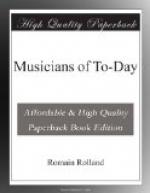At Strasburg Strauss conducted his Sinfonia Domestica, whose programme seems boldly to defy reason, and even good taste. In the symphony he pictures himself with his wife and his boy ("Meiner lieben Frau und unserm Jungen gewidmet"). “I do not see,” said Strauss, “why I should not compose a symphony about myself; I find myself quite as interesting as Napoleon or Alexander.” Some people have replied that everybody else might not share his interest. But I shall not use that argument; it is quite possible for an artist of Strauss’s worth to keep us entertained. What grates upon me more is the way in which he speaks of himself. The disproportion between his subject and the means he has of expressing it is too strong. Above all, I do not like this display of the inner and secret self. There is a want of reticence in this Sinfonia Domestica. The fireside, the sitting-room, and the bedchamber, are open to all-comers. Is this the family feeling of Germany to-day? I admit that the first time I heard the work it jarred upon me for purely moral reasons, in spite of the liking I have for its composer. But afterwards I altered my first opinion, and found the music admirable. Do you know the programme?
The first part shows you three people: a man, a woman, and a child. The man is represented by three themes: a motif full of spirit and humour, a thoughtful motif, and a motif expressing eager and enthusiastic action. The woman has only two themes: one expressing caprice, and the other love and tenderness. The child has a single motif, which is quiet, innocent, and not very defined in character; its real value is not shown until it is developed.... Which of the two parents is he like? The family sit round him and discuss him. “He is just like his father” (Ganz der Papa), say the aunts. “He is the image of his mother” (Ganz die Mama), say the uncles.
The second part of the symphony is a scherzo which represents the child at play; there are terribly noisy games, games of Herculean gaiety, and you can hear the parents talking all over the house. How far we seem from Schumann’s good little children and their simple-hearted families! At last the child is put to bed; they rock him to sleep, and the clock strikes seven. Night comes. There are dreams and some uneasy sleep. Then a love scene.... The clock strikes seven in the morning. Everybody wakes up, and there is a merry discussion. We hear a double fugue in which the theme of the man and the theme of the woman contradict each other with exasperating and ludicrous obstinacy; and the man has the last word. Finally there is the apotheosis of the child and family life.




